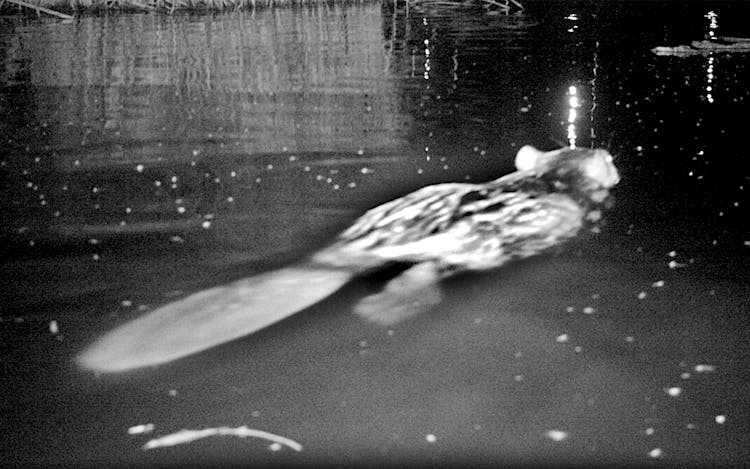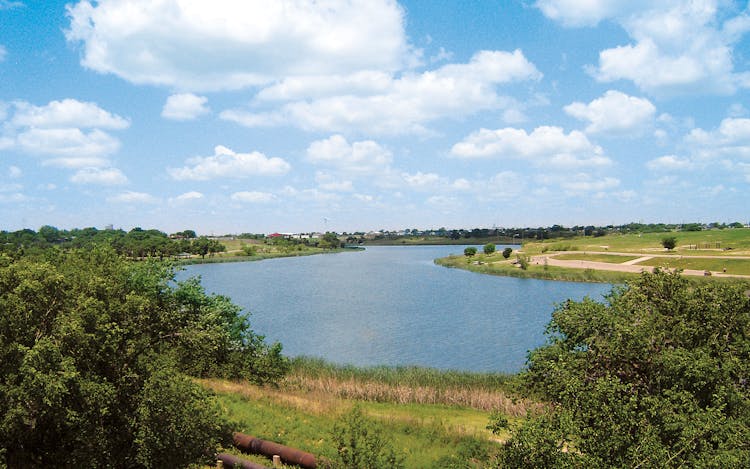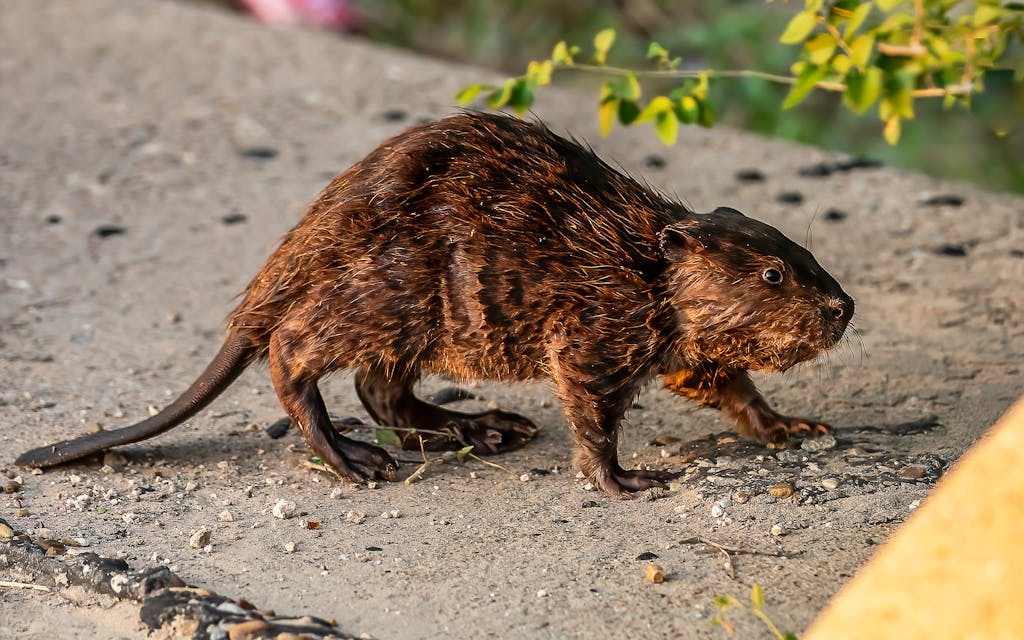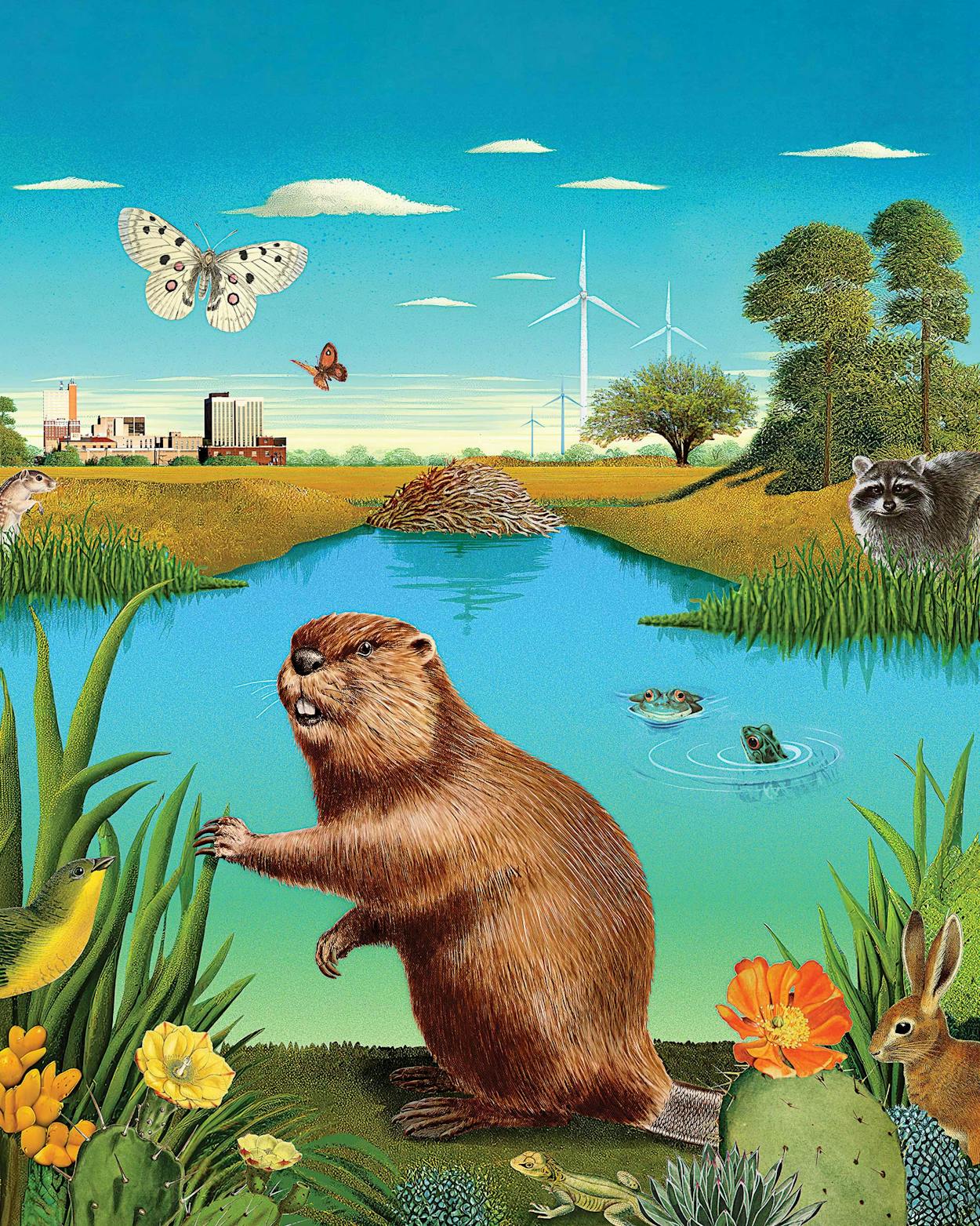When it comes to Castor canadensis, a.k.a. the North American beaver, there’s no shortage of fascinating facts: It’s the continent’s largest rodent; it can hold its breath for as long as fifteen minutes; and it has a third eyelid on each eye, a translucent one that serves as natural goggles when the semiaquatic animal is submerged. The beaver also secretes an odorous goo, known as castoreum, that it uses to waterproof its thick, double-coated fur and to mark its territory. The goo is also included as a compound in some perfumes.
Perhaps most impressive, however, is the reverberatory effect the rodents have on the landscapes they inhabit. Beavers are known as a keystone species, an animal whose presence determines the fate of much of the flora and fauna in a particular ecosystem. This designation stems from their well-known ability to build wetlands from scratch, transforming a single stream into a biodiverse pond that supports many other living creatures, from frogs to waterfowl. Because of their singular ability to breathe life into land that is otherwise barren, there is even hope that beavers could help ranchers heal some of the most drought-stricken parts of West Texas—places where, until recently, the rodents hadn’t been seen for thousands of years.
An animal being hard to find has never stopped intrepid hunters from searching for it. Albert Pike was one of those hunters. In the spring of 1831, the young Boston-born teacher and poet uprooted his predictable life in New England and headed west. Lacking both money and a discernible plan, Pike joined a group of traders and hunters in Missouri who were headed for New Mexico. Soon after arriving, he left Santa Fe to embark on an expedition to the Llano Estacado, an elevated expanse of desolate grassland that covers parts of northwest Texas and eastern New Mexico. They were in search of beavers, whose pelts had been prized by European hatmakers for centuries, leading to the decimation of the animal’s population in North America. Little did Pike know, the rodents hadn’t made an appearance in the area around what today is Lubbock for about five thousand years. He eventually abandoned his quest but later wrote about his adventures in 1834’s Narrative of a Second Journey in the Prairie. (Pike went on to become a Freemason as well as a disgraced Confederate general whose Washington, D.C., statue was toppled in 2020.)
Nearly two centuries later, another Massachusetts native and naturalist—whose high school was less than twenty miles from the academy that Pike attended—found himself adjusting to life on the southern High Plains. Garret Langlois had lived in Vermont, Louisiana, and the Paraguayan jungle, where he’d studied tropical fruit bats, but he’d never set foot in Texas. That changed in 2015, when one of his academic mentors persuaded Langlois to join him at Texas Tech University and pursue a doctorate in wildlife ecology in the school’s Department of Natural Resources Management. Unlike Pike, Langlois, whose work focuses on behavioral ecology, wasn’t looking for beavers. Though he’d studied snakes and salamanders and has a general passion for wildlife, Langlois had never given the same attention to the toothy rodents.
But soon after he arrived at Texas Tech, a couple of biology students and their professor found a beaver carcass in Mackenzie State Recreation Area, the 542-acre swath of green space on the northeast side of the city that is home to a prairie dog town and a man-made lake. Langlois became obsessed with the idea of determining whether the lone beaver was a fluke or the first evidence that the animals had returned to the Lubbock area. Should the latter turn out to be true, Langlois knew that it would be a shocking development, one that would captivate wildlife experts all over the country.


The fossil record shows that beavers were living in north-central Texas as far back as 125,000 years ago, before continuing to expand their range southwest to the New Mexico–Mexico border and into Arizona. The same record indicates they were wiped out from the Llano Estacado by two severe droughts, around 3000 BC, and never managed to return. Beavers were later trapped and exterminated nearly to extinction during the North American fur trade, which, according to Langlois, contributed to the destruction of critical wetlands that moisturized dehydrated landscapes, supported biodiversity, and lowered temperatures all over the United States. While beavers have recently begun to recolonize areas such as Northern California, where they had been nearly eradicated, their North American population is estimated to be only one tenth of what it was before European settlement.
Today in Texas, beavers are plentiful in wetter, eastern parts of the state. They’ve also been spotted almost any place where there’s an adequate supply of water, from remote Hill Country streams to as far west as El Paso. But while beavers had returned to a single location on the Llano Estacado—Randall County, in northwestern Texas—they were thought to still be absent in the rest of the region. If they had indeed turned up in Lubbock’s semiarid climate thousands of years after disappearing, remaining undetected despite being surrounded by hundreds of thousands of humans, their covert arrival would be a testament to the creature’s awe-inspiring resilience. “Like people, animals are always looking for new places to expand their range and make a livelihood,” Langlois said. “But this is a tough place to colonize, especially for an animal that thrives in freshwater ecosystems. It’s dry, and there’s not a lot of water here in general.”
After finding no other evidence of beaver activity at Mackenzie, Langlois used what little spare time he had to collect water samples and talk to strangers along the shores of Canyon Lake Number 6 (also known as Dunbar Historical Lake), in Mae Simmons Park, just a couple of miles southeast of Mackenzie. Like a detective working on a missing-person case, he asked everyone he encountered if they’d recently spotted a beaver in the area. Though rumors of sightings abounded, he eventually realized that the only path forward was to see one of the animals for himself. For months he explored the dense, wooded areas around the lake, observing subtle interactions between fauna and flora and sometimes getting down on his hands and knees to look for evidence of the animals’ impact on the area, keeping in mind that beavers are primarily nocturnal. When Langlois wrote about this period in an exchange over email, his prose read as if that same detective grew up reading the writings of some of the great nineteenth-century American naturalists, including Albert Pike. Langlois’s eye for detail is so precise and passionate, it manages to turn an overlooked urban park into an enchanting wilderness:
I walked down a slope of shortgrass prairie, into a floodplain hardwood forest, across a desiccated depressional marsh, and finally into the riparian hardwood forest. While surveying the lakeshore, I kept thinking to myself that if I were a beaver in Lubbock, this is where I’d be. Adjacent to the mouth of a rheocrene spring-fed brook, I stooped down to get a better look at the first piece of evidence that would support a hypothesis for beaver habitation in the Canyon Lakes: chewed stumps from one to three seasons past. So, they were here at one point . . . but were they still here?
Eventually, a more complete answer would arrive in several forms: a partially collapsed tunnel opening; places where foliage had been squashed, indicating a potential entry and exit route along the water; and tree stumps that appeared to have been stripped of bark and sliced open by large incisors. The discoveries were largely confined to one area, but Langlois found signs of older trails and additional chew marks in other locations. Despite these compelling findings, the rodents—which typically weigh forty to seventy pounds—remained frustratingly elusive. “I could’ve published a paper showing the environmental evidence and the chew marks, but scientist or not, who is going to get excited about that?” Langlois said. “Do you want to see photos of a few chewed-up tree stumps, or do you want to see undeniable evidence of beavers being in a place they haven’t been for five thousand years?”
Langlois knew what he had to do: somehow, he’d need to capture photographic evidence of a live beaver. In the spring of 2018, using three borrowed motion-activated digital cameras that he mounted on trees, he set up what was essentially a sting operation along the bank near a suspected beaver den he’d discovered. Finally, after four months—and a lot of anxiety over the prospect of the expensive equipment being stolen—Langlois got what he had been hoping for: a black and white image of a pair of North American beavers swimming, one behind the other, in Canyon Lake Number 6, their large oval tails trailing behind. Langlois was lucky—about a day after the image was snapped, a spider built a web over the lens, rendering the camera useless.

In the nearly five years since, Langlois has seen beavers in the area only a handful of times, and always fleetingly, which explains his penchant for comparing them to ghosts. He keeps an unofficial eye on the population and worries about their safety. Some have been hit by cars in Lubbock, and their future in the region, while full of potential, remains uncertain. “Knowing they mate for life always makes it extra hard for me to see one crumpled up on the roadside,” Langlois said. “In a way, I also relate to them, because both the beavers and I are strangers in this strange land of West Texas.” He might receive help tracking the beaver community from university students, the same young people who have begun making playful memes about Langlois’s research. If more students do begin studying the animals, they’ll quickly discover that beavers may remain as hard as ever to spot in the wild.
Langlois has come to believe that the animals’ elusiveness could be a form of intelligent adaptation. Unlike beavers in the northeastern United States, which build prodigious lodges and slap their tails on the water when people venture too close, their pioneering cousins on the Llano Estacado are colonizing with caution. They burrow underground, typically venture out after dark, and, Langlois speculates, may have chosen to hunker down near the nests of loud shoreline birds. “If you’re new to an area and in an urban environment and you know you’re not the most comfortable on land, wouldn’t living in a place with a bird-based alarm system be the best thing that could happen to you?” Langlois said, pointing out that scientists do know of examples of animals listening to other species to gather information and reacting accordingly.
After assembling evidence from nearly 100 river miles that dates back more than a decade, Langlois has concluded that beaver colonies in Lubbock can most likely be traced to colonies in the Brazos River in north-central Texas, more than 230 river miles to the east. The population likely required years to complete the journey from there, its arrival possibly coinciding with heavy rains during the summer of 2015. More recently, he’s discovered evidence of beaver habitation occurring intermittently from nearly all of the Canyon Lakes to roughly 50 river miles downstream. Asked how many beavers might be in Lubbock, Langlois was reluctant to speculate. What he’s more confident about is the opportunity for the new colonies to positively affect the city and the region.
A paper showcasing his research into the beaver’s recolonization efforts was published last year. And Texas Tech president Lawrence Schovanec praised Langlois’s findings in a recent state of the university address. For drought-plagued parts of Texas, Langlois is already considering whether beavers could be used to construct natural dams that assist in prairie restoration and has discussed the idea with a local rancher. He also points to research that links human contact with nature with greater social cohesion.
Perhaps not surprisingly, the devoted naturalist thinks beavers could serve as a sort of gateway that helps more Lubbock residents engage with the natural world around them, appreciating landscapes they may have overlooked. As evidence, he cites himself. “I hadn’t felt connected to Texas, and especially not West Texas, until I began studying these animals,” Langlois said. “I didn’t feel like I had a place here. Now a week doesn’t go by without me driving or hiking through the Canyon Lakes to spend time in the woods that I’ve come to know through the beaver.”
This article appeared in the April 2023 issue of Texas Monthly with the headline “Hot Dam! Beavers Are Back In Lubbock.” It originally published online on September 6, 2022, and has since been updated. Subscribe today.
related video
Garret Langlois discusses his discovery in the latest dispatch from Texas Country Reporter.









